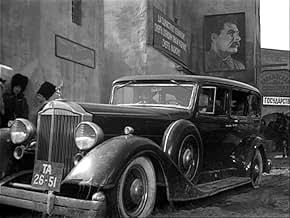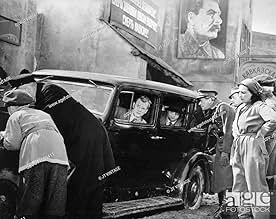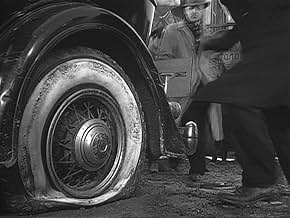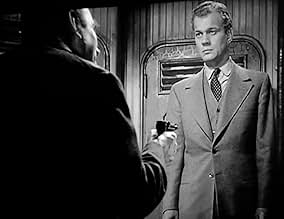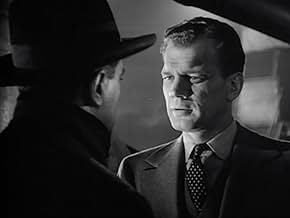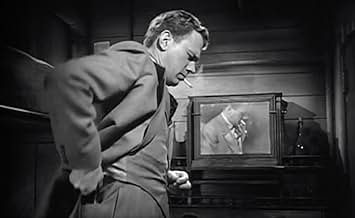IMDb-BEWERTUNG
6,5/10
5005
IHRE BEWERTUNG
Füge eine Handlung in deiner Sprache hinzuAn American ballistics expert in Turkey finds himself targeted by German agents. Safe passage home by ship is arranged for him, but he soon discovers that his pursuers are also on board.An American ballistics expert in Turkey finds himself targeted by German agents. Safe passage home by ship is arranged for him, but he soon discovers that his pursuers are also on board.An American ballistics expert in Turkey finds himself targeted by German agents. Safe passage home by ship is arranged for him, but he soon discovers that his pursuers are also on board.
Dolores Del Río
- Josette Martel
- (as Dolores Del Rio)
Anna De Linsky
- Russian Maid at Batumi Hotel
- (Nicht genannt)
Jerome de Nuccio
- Turkish Officer
- (Nicht genannt)
Herbert Drake
- Ship's Steward
- (Nicht genannt)
Empfohlene Bewertungen
The operatic approach of adding a musical dimension to menace with a killer-theme on the soundtrack has been greatly used in Orson Welles' glorious suspense film, "Journey Into Fear," where the little killer obsessively played a scratchy old 78 rpm disc of someone singing "Chagrin d'Amour."
The assassin was short and fat; his belly large, his chin and neck flabby... I do not recall him having a line of dialog to speak But the whole film was spread with heightened menace when he sat, his little round eyes blank behind his little round pebble lenses, listening compulsively to the atrociously scratchy record, confusing the words of the song at the wrong speed, the needle jumping from groove to groove; his nerve-ends, unlike ours, immune to the discordance
This was a spy thriller set in the wartime Near East, about an innocent American engineer (Joseph Cotten), pursued by Nazi agents and blundering from danger to danger without seeming to know too much of what it was all about It was essentially a hunter-and-hunted story, with settings that were often seedy but always exotic
The opening was in Istanbul, the climax in Batum, and all the terrors between were forced claustrophobically between the low ceilings and narrow partitions of a neglected little steamer plowing the Black Sea
"Journey Into Fear" lives for its portrait gallery, its atmosphere, and for Welles' touches and excesses
The assassin was short and fat; his belly large, his chin and neck flabby... I do not recall him having a line of dialog to speak But the whole film was spread with heightened menace when he sat, his little round eyes blank behind his little round pebble lenses, listening compulsively to the atrociously scratchy record, confusing the words of the song at the wrong speed, the needle jumping from groove to groove; his nerve-ends, unlike ours, immune to the discordance
This was a spy thriller set in the wartime Near East, about an innocent American engineer (Joseph Cotten), pursued by Nazi agents and blundering from danger to danger without seeming to know too much of what it was all about It was essentially a hunter-and-hunted story, with settings that were often seedy but always exotic
The opening was in Istanbul, the climax in Batum, and all the terrors between were forced claustrophobically between the low ceilings and narrow partitions of a neglected little steamer plowing the Black Sea
"Journey Into Fear" lives for its portrait gallery, its atmosphere, and for Welles' touches and excesses
Orson Welles graciously denied having any directing role in Norman Foster's 'Journey into Fear (1943),' though his influence appears to be all over it. 'Citizen Kane (1941)' first showcased Welles' fondness for filming people via low and high-angled cameras, a stylistic technique that distorts statures, placing the audience in a position either of power or helplessness. Here, the talented Karl Struss who also worked on such films as 'Sunrise: A Song of Two Humans (1927)' and 'Dr. Jekyll and Mr. Hyde (1931)' employs similar techniques, capturing human faces with a threatening immediacy that distorts their features and suggests imminent danger. You won't, of course, fail to notice that the film's cast also boasts more than a few Welles regulars, mostly members of his Mercury Theatre team Joseph Cotten, Agnes Moorehead, Everett Sloane, Ruth Warrick and Welles himself. The film's screenplay was written by Cotten, his sole attempt at writing {outside some uncredited work on 'The Magnificent Ambersons (1942)'}, a pity since the dialogue is frequently crisp, intelligent and memorable.
'Journey into Fear' is one of those rare WWII-themed films of the early 1940s that you wouldn't automatically class as propaganda. Indeed, the Nazis are only mentioned in passing, and the sinister agents who attempt to assassinate Cotten could just as easily be motivated by reasons other than war. Much of the story takes place on a small passenger ship, on which American engineer Howard Graham (Cotten) seeks refuge from German assassins, who are hell-bent on delaying his return home with important Allied intelligence. Silent enemy Peter Banat (played by Welles' agent, Jack Moss) watches ominously from across the ship's cabin, never saying a word, but suggesting sadistic menace through every dryly-amused smirk. Cotten is strong in the lead role, playing Graham as a frightened and confused amateur, a role reminiscent of Holly Martins from 'The Third Man (1949),' rather than the experienced and resourceful American spy we would otherwise expect in such a film. Welles lends his mighty presence to the role of the Turkish Colonel Haki, though he is noticeably more subdued than usual.
In one final manner, 'Journey into Evil' is very much like an Orson Welles film: it was re-edited at the studio's request. According to some sources, Welles did some of the trimming himself, recutting the final reel and adding Joseph Cotten's rather awkward narration. At just 68 minutes in length, the film certainly feels as though it has been tampered with. The relationship between Graham and Rosette (Dolores del Rio) is brief and poorly explored, and certainly not worthy of the repeated reassurances that the former frequently bestows upon his anxious wife (Ruth Warrick); there's little indication that the their affiliation extended beyond exchanging a few harmless pleasantries. Though the film doesn't exactly feel incomplete as did a noir like Renoir's 'The Woman on the Beach (1947)' the bare-bones narrative gives the sense of a minor and inconsequential work. Even so, 'Journey into Evil' is well worth seeking out for its terrific photography including a superb climax on the slippery ledges of a hotel exterior and the talents of a very talented cast.
'Journey into Fear' is one of those rare WWII-themed films of the early 1940s that you wouldn't automatically class as propaganda. Indeed, the Nazis are only mentioned in passing, and the sinister agents who attempt to assassinate Cotten could just as easily be motivated by reasons other than war. Much of the story takes place on a small passenger ship, on which American engineer Howard Graham (Cotten) seeks refuge from German assassins, who are hell-bent on delaying his return home with important Allied intelligence. Silent enemy Peter Banat (played by Welles' agent, Jack Moss) watches ominously from across the ship's cabin, never saying a word, but suggesting sadistic menace through every dryly-amused smirk. Cotten is strong in the lead role, playing Graham as a frightened and confused amateur, a role reminiscent of Holly Martins from 'The Third Man (1949),' rather than the experienced and resourceful American spy we would otherwise expect in such a film. Welles lends his mighty presence to the role of the Turkish Colonel Haki, though he is noticeably more subdued than usual.
In one final manner, 'Journey into Evil' is very much like an Orson Welles film: it was re-edited at the studio's request. According to some sources, Welles did some of the trimming himself, recutting the final reel and adding Joseph Cotten's rather awkward narration. At just 68 minutes in length, the film certainly feels as though it has been tampered with. The relationship between Graham and Rosette (Dolores del Rio) is brief and poorly explored, and certainly not worthy of the repeated reassurances that the former frequently bestows upon his anxious wife (Ruth Warrick); there's little indication that the their affiliation extended beyond exchanging a few harmless pleasantries. Though the film doesn't exactly feel incomplete as did a noir like Renoir's 'The Woman on the Beach (1947)' the bare-bones narrative gives the sense of a minor and inconsequential work. Even so, 'Journey into Evil' is well worth seeking out for its terrific photography including a superb climax on the slippery ledges of a hotel exterior and the talents of a very talented cast.
While returning from a conference munitions expert Joseph Cotten and his wife Ruth Warrick are taken to a nightclub in Istanbul by the mysterious Edward Sloane where Cotten is almost killed. Magician Hans Conreid is a victim of his own slight of hand, but it's Cotten who's the target as Orson Welles as the Turkish police inspector deduces.
Welles's solution get Cotten out of the country so if he's killed at least it won't be on his watch. Welles books passage on a tramp freighter for Cotten and the freighter is loaded with highly interesting characters, one of whom at least is a Nazi assassin.
This was another Mercury Theater production with most of the regulars from Citizen Kane/The Magnificent Ambersons back again. Welles's police inspector is a small, but crucial part of the story.
Welles, for whatever reason is being unduly modest. Journey Into Fear is undoubtedly the greatest film that Orson Welles never took credit for directing. I can find certain touches here from Citizen Kane, The Magnificent Ambersons, and The Stranger. If he didn't officially direct you can take it to the bank that Norman Foster knew exactly what Welles was trying to get out of each and every scene.
Look also here for a good performance by Mexican cinema great Dolores Del Rio as a most mysterious femme fatale on the freighter.
Journey Into Fear is a short film, slightly less than 70 minutes running time. I'm sure that RKO had it playing at the bottom end of double features. Maybe we'll see a 'director's cut' of this one day and know what Welles's own perspective was.
Welles's solution get Cotten out of the country so if he's killed at least it won't be on his watch. Welles books passage on a tramp freighter for Cotten and the freighter is loaded with highly interesting characters, one of whom at least is a Nazi assassin.
This was another Mercury Theater production with most of the regulars from Citizen Kane/The Magnificent Ambersons back again. Welles's police inspector is a small, but crucial part of the story.
Welles, for whatever reason is being unduly modest. Journey Into Fear is undoubtedly the greatest film that Orson Welles never took credit for directing. I can find certain touches here from Citizen Kane, The Magnificent Ambersons, and The Stranger. If he didn't officially direct you can take it to the bank that Norman Foster knew exactly what Welles was trying to get out of each and every scene.
Look also here for a good performance by Mexican cinema great Dolores Del Rio as a most mysterious femme fatale on the freighter.
Journey Into Fear is a short film, slightly less than 70 minutes running time. I'm sure that RKO had it playing at the bottom end of double features. Maybe we'll see a 'director's cut' of this one day and know what Welles's own perspective was.
The ingredients are there for first-class international intrigue—Welles, Cotten, an Ambler novel, and the terrific RKO team of D' Agostino and Silvera behind so much of the studio's b&w artistry. So why is the end result short of the classic it should be. IMDb lists 3 uncredited writers in addition to the credited Cotten. Maybe that's why the narrative is so choppy as other reviewers point out. Then too, maybe the studio exercised a heavy hand in the editing room as they were known to do. Whatever the reason, the story never really gels into the suspenser it should be, despite the impressive visuals so clearly Wellsian.
Nonetheless, the nightclub scene especially stays with me. Catch the neatly choreographed staging as the characters dart in and out of the foreground reminiscent of the high-kicking dance scene in Citizen Kane. And who else but a magician (Hans Conreid) would trick himself into a casket with such Wellsian flourish. Note too how visually appropriate non- actor Jack Moss is as the "obese gunman". Apparently, he couldn't be entrusted with any lines, but looking like a mutant garden slug he rivets the eye by sinister presence alone. In fact, this may be the kind of film made more enjoyable by turning down the sound and just reveling in the visuals. Yes indeed, the narrative may disappoint, but the very real Wellsian compensations remain.
Nonetheless, the nightclub scene especially stays with me. Catch the neatly choreographed staging as the characters dart in and out of the foreground reminiscent of the high-kicking dance scene in Citizen Kane. And who else but a magician (Hans Conreid) would trick himself into a casket with such Wellsian flourish. Note too how visually appropriate non- actor Jack Moss is as the "obese gunman". Apparently, he couldn't be entrusted with any lines, but looking like a mutant garden slug he rivets the eye by sinister presence alone. In fact, this may be the kind of film made more enjoyable by turning down the sound and just reveling in the visuals. Yes indeed, the narrative may disappoint, but the very real Wellsian compensations remain.
Joseph Cotten plays an American armaments engineer on the run from the Nazis in "Journey into Fear," a 1943 film with a script by Cotten (from a story by Eric Ambler) and costarring Orson Welles and Delores del Rio. Cotten is working on a deal to supply Turkey with weapons to fight the Axis. The Nazis don't want the deal made and are trying to stop Cotten from getting back to the U.S.
There are some very exciting scenes in this extremely atmospheric film, in particular on the ledge of a building between Cotten and the terrifying assassin. Most of the film takes place on board a dingy ship where Cotten is taken, thus beginning his Kafka-esquire nightmare.
This is an entertaining film for sure, but I've always been troubled by it. First of all, it seems like there are scenes missing. Second, it's on the confusing side since there are irrelevant characters thrown in. Third, you can drive a truck through some of the plot holes. Fourth, the ending to me has always felt abrupt.
Suspenseful? Yes. Intriguing? Yes. Ultimately disappointing? Yes. Cotten is good as a man blundering through something he can't quite figure out - the problem is, the audience can't quite figure it out either. Welles has a small but effective role as Dr. Haki.
Strong on style, weak on substance.
There are some very exciting scenes in this extremely atmospheric film, in particular on the ledge of a building between Cotten and the terrifying assassin. Most of the film takes place on board a dingy ship where Cotten is taken, thus beginning his Kafka-esquire nightmare.
This is an entertaining film for sure, but I've always been troubled by it. First of all, it seems like there are scenes missing. Second, it's on the confusing side since there are irrelevant characters thrown in. Third, you can drive a truck through some of the plot holes. Fourth, the ending to me has always felt abrupt.
Suspenseful? Yes. Intriguing? Yes. Ultimately disappointing? Yes. Cotten is good as a man blundering through something he can't quite figure out - the problem is, the audience can't quite figure it out either. Welles has a small but effective role as Dr. Haki.
Strong on style, weak on substance.
Wusstest du schon
- WissenswertesThe great stage actor Richard Bennett had been brought back to films by Orson Welles for Der Glanz des Hauses Amberson (1942). Although his performance as old Major Amberson has become legendary, it was achieved with great difficulty, as Bennett, by then an old man near death, found it hard to remember his lines, and his eyesight was too poor for him to be able to read cue-cards. Welles's patience in dealing with these problems has been widely described. When he cast Bennett as the ship's captain, he overcame the problems simply by giving Bennett no dialogue at all, although the character has several memorable scenes. It was Bennett's final film role.
- PatzerDuring the chase outside the hotel in the rain, Banat's pistol, a P-08 "Luger" runs out of ammunition, but the action closes normally after he fires the last shot. This particular pistol was designed so that the action stays open after the last round is fired, giving a clear indication to the user that the gun is empty.
- Zitate
Colonel Haki: Ah, you have this advantage over the soldier, Mr. Graham. You can run away without being a coward.
- Alternative VersionenIn 2005 an alternate cut was shown at the Orson Welles film retrospective in Locarno, Switzerland. It was the original European release print, lacking the narration and ending of the US version but including about eight minutes of footage later deleted by RKO, reportedly for political and censorship reasons. This alternate version, assembled by Stefan Droessler of the Münchner Filmmuseum, was shown at the Museum of Modern Art on Saturday, November 21, 2015.
- VerbindungenFeatured in Terminus... the Theater of Science Fiction: Journey into Fear (1970)
- SoundtracksC'est mon coeur
(uncredited)
Written by Steven Morgan
Top-Auswahl
Melde dich zum Bewerten an und greife auf die Watchlist für personalisierte Empfehlungen zu.
- How long is Journey Into Fear?Powered by Alexa
Details
- Erscheinungsdatum
- Herkunftsland
- Sprachen
- Auch bekannt als
- Jornada de terror
- Drehorte
- Produktionsfirmen
- Weitere beteiligte Unternehmen bei IMDbPro anzeigen
- Laufzeit1 Stunde 8 Minuten
- Farbe
- Seitenverhältnis
- 1.37 : 1
Zu dieser Seite beitragen
Bearbeitung vorschlagen oder fehlenden Inhalt hinzufügen

